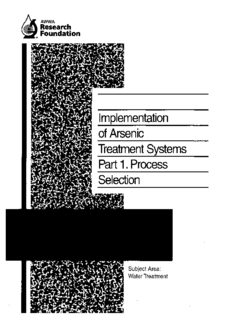Table Of ContentAWWA
Research
Foundation
Implementation
of Arsenic
Treatment Systems
Part 1. Process
Selection
Subject Area:
Water Treatment
Implementation
of Arsenic
Treatment Systems
Part 1. Process
Selection
The mission of the Awwa Research Foundation is to advance the science of water to improve
the quality of life. Funded primarily through annual subscription payments from over 1,000 utili
ties, consulting firms, and manufacturers in North America and abroad, AwwaRF sponsors
research on all aspects of drinking water, including supply and resources, treatment, monitoring
and analysis, distribution, management, and health effects.
From its headquarters in Denver, Colorado, the AwwaRF staff directs and supports the efforts
of over 500 volunteers, who are the heart of the research program. These volunteers, serving on
various boards and committees, use their expertise to select and monitor research studies to ben
efit the entire drinking water community.
Research findings are disseminated through a number of technology transfer activities, includ
ing research reports, conferences, videotape summaries, and periodicals.
Implementation
of Arsenic
Treatment Systems
Part 1. Process
Selection_____
Prepared by:
Zaid Chowdhury and Sunil Kommineni
Malcolm Pirnie, Inc.
432 N. 44th Street, Suite 400
Phoenix, AZ 85008
Ramesh Narasimhan and John Brereton
Narasimhan Consulting Services Inc.
3150 N. 24th Street, Suite D-104
Phoenix, AZ 85016
Gary Amy and Shahnawaz Sinha
University of Colorado at Boulder
ECOT 441
Boulder, CO 80309
Jointly sponsored by:
Awwa Research Foundation
6666 West Quincy Avenue
Denver, CO 80235-3098
and
United States Environmental Protection Agency
1200 Pennsylvania Avenue, NW
Washington, DC 20460-0003
Published by the
Awwa Research Foundation and
American Water Works Association
Disclaimer
This study was jointly funded by the Awwa Research Foundation (AwwaRF) and the U.S. Environmental Protection
Agency (USEPA) under Cooperative Agreement No. CR827268-01. AwwaRF and USEPA assume no responsibility
for the content of the research study reported in this publication or the opinions or statements of fact expressed in the
report. The mention of trade names for commercial products does not represent or imply the approval or endorsement
of AwwaRF or USEPA. This report is presented solely for informational purposes.
Library of Congress Cataloging-in-Publication Data has been applied for;
Copyright 2002
by
Awwa Research Foundation
and
American Water Works Association
Printed in the U.S.A.
ISBN 1-58321-236-1
Printed on recycled paper
CONTENTS
LIST OF TABLES.......................................................................................................................xiii
LIST OF FIGURES....................................................................................................................... xv
FOREWORD .............................................................................................................................xvii
ACKNOWLEDGMENTS ...........................................................................................................xix
EXECUTIVE SUMMARY..........................................................................................................xxi
CHAPTER 1: BACKGROUND AND INTRODUCTION........................................................... 1
Background......................................................................................................................... 1
Regulatory Update................................................................................................... 1
Compliance Status................................................................................................... 2
Introduction......................................................................................................................... 3
Project Objectives................................................................................................... 3
Proven Arsenic Treatment Technologies................................................................ 5
Emerging Arsenic Treatment Technologies............................................................ 9
CHAPTER 2: TREATMENT TECHNOLOGIES AND WATER QUALITY
CONSIDERATIONS........................................................................................................ 13
Arsenic Chemistry............................................................................................................. 13
Ion Exchange..................................................................................................................... 15
Water Quality Considerations............................................................................... 19
Regeneration.......................................................................................................... 22
Residuals Handling............................................................................................... 22
Adsorptive Processes......................................................................................................... 22
Water Quality Considerations............................................................................... 25
Regeneration..........................................................................................................29
Residuals Handling for On-Site AA Regeneration Systems................................. 29
Throwaway AA..................................................................................................... 30
Granular Ferric Hydroxide.................................................................................... 30
Precipitative Processes...................................................................................................... 36
Conventional Treatment........................................................................................36
Iron and Aluminum Coagulation........................................................................... 38
Water Quality Impacts.......................................................................................... 39
Residuals Handling............................................................................................... 40
Enhanced Softening............................................................................................... 42
Oxidation/Filtration Processes.............................................................................. 44
Greensand Filtration Systems................................................................................ 45
Iron Removal Plants.............................................................................................. 46
Residuals Handling (for Oxidation/Filtration Systems)........................................ 48
Membrane Processes......................................................................................................... 48
Coagulation-Assisted Microfiltration.................................................................... 49
Water Quality Considerations............................................................................... 50
Residuals Handling............................................................................................... 51
Nanofiltration and Reverse Osmosis..................................................................... 52
Water Quality Considerations............................................................................... 53
Residuals Handling............................................................................................... 55
Partial Stream Treatment................................................................................................... 56
Point of Entry vs. Wellhead Treatment............................................................................. 57
CHAPTER 3: RESIDUALS HANDLING AND DISPOSAL..................................................... 59
Residuals Handling Options.............................................................................................. 59
Ion Exchange......................................................................................................... 59
Adsorptive Processes............................................................................................. 60
Precipitative Processes.......................................................................................... 61
Membrane Processes............................................................................................. 62
Dewatering Considerations .................................................................................. 62
Hazard Potential of Arsenic Residuals.............................................................................. 63
Computing Arsenic Residuals Volumes and Characteristics............................................ 66
Ion Exchange.........................................................................................................67
Adsorptive Processes............................................................................................. 71
Precipitative Processes..........................................................................................77
VI
Membrane Processes.............................................................................................78
CHAPTER 4: SELECTION AND INTEGRATION OF ARSENIC
REMOVALTECHNOLOGIES......................................................................................... 81
Decision Tree Tool for Systems with Existing Treatment................................................ 82
Decision Trees for Existing Treatment Systems................................................... 82
Surface Water - Existing Conventional Treatment............................................... 83
Surface Water - Existing Direct Filtration............................................................ 86
Groundwater/Surface Water - Existing Precipitative Softening........................... 88
Groundwater/Surface Water - Existing Iron Removal Process
(Oxidation/Filtration)................................................................................ 90
Groundwater/Surface Water - Existing Iron and Manganese Removal Process
(Manganese Greensand Filtration)............................................................ 90
Groundwater- No Existing Treatment................................................................... 93
Spreadsheet Decision Tree Tool for Systems with No Existing Treatment...................... 96
Applicable Treatment and Residuals Handling/Disposal Trains.......................... 96
Decision Analysis Tool Overview........................................................................ 98
Mandatory Inputs..................................................................................................99
Residuals Estimations........................................................................................... 99
Costs Calculations...............................................................................................100
Other Computations............................................................................................ 100
Critical Decision Drivers and Technology Feasibility Evaluation...................... 100
Qualitative Decision Drivers and Ranking of Feasible Alternatives.................. 102
Summary Output of the Most Preferred Alternatives......................................... 103
Qualitative Guidance on Innovative Technologies......................................................... 103
CHAPTERS: COSTS................................................................................................................ 105
Introduction..................................................................................................................... 105
Treatment Unit Costs.......................................................................................... 105
Residuals Handling and Disposal Unit Costs...................................................... 107
Treatment Cost Assumptions.......................................................................................... 108
Vll
Enhanced Coagulation/Filtration......................................................................... 108
Enhanced Lime Softening................................................................................... 113
Direct Filtration to Conventional Filtration........................................................ 114
Throwaway Activated Alumina.......................................................................... 114
Granular Ferric Hydroxide.................................................................................. 115
Conventional Activated Alumina........................................................................ 116
Ion Exchange....................................................................................................... 118
Coagulation-Assisted Microfiltration.................................................................. 119
Nanofiltration/Reverse Osmosis......................................................................... 119
Electrodialysis Reversal...................................................................................... 120
Iron/Manganese Removal................................................................................... 120
Residuals Handling and Disposal Cost Assumptions..................................................... 120
Residuals Handling Alternatives......................................................................... 121
Residuals Disposal Alternatives.......................................................................... 123
Pre-Oxidation Cost.......................................................................................................... 126
Land Cost........................................................................................................................ 127
CHAPTER 6: UTILITY CASE STUDY SUMMARIES .......................................................... 129
City of Phoenix, Arizona................................................................................................. 129
Background......................................................................................................... 129
Operational Characteristics................................................................................. 131
Evaluation of Treatment Technologies for Well #280........................................ 134
Systemwide Evaluation of Treatment Technologies........................................... 136
Blending Options................................................................................................. 136
Summary............................................................................................................. 137
City of Tucson, Arizona.................................................................................................. 138
Background......................................................................................................... 138
Operational Characteristics................................................................................. 138
Evaluation of Treatment Technologies Using Spreadsheet Tool........................ 139
Summary............................................................................................................. 140
City of Scottsdale, Arizona............................................................................................. 141
Vlll
Description:Coagulation-Assisted Microfiltration.. 49. Water Quality Considerations .. Water System A (Anonymous), Arizona.

